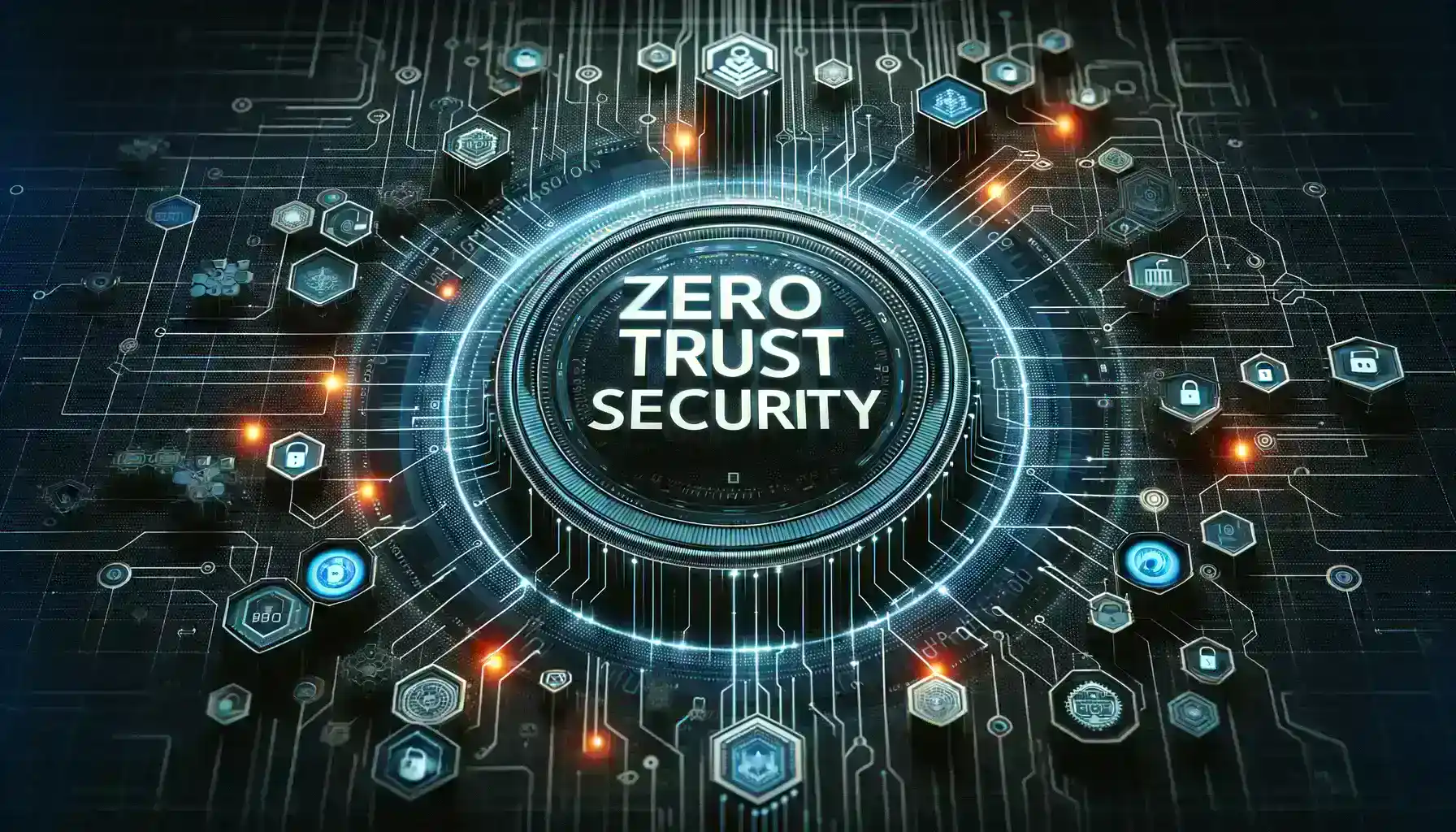Table of Contents
In the ever-evolving landscape of cybersecurity, the traditional perimeter-based approach to network security is proving inadequate. Enter Zero Trust Security—a paradigm shift that challenges the notion of implicit trust within a network. This article explores the principles of Zero Trust Security, exploring its relevance in the digital age and providing real-time instances of organizations successfully implementing this transformative security model.
1. Understanding Zero Trust Security
Never Trust, Always Verify: Zero Trust fundamentally challenges the traditional security model that relies on the assumption that entities within a network are inherently trustworthy. Instead, it adopts a “never trust, always verify” mantra. This means that every user, device, or application attempting to connect to the network must undergo a verification process, regardless of their location or previous level of access.

For instance, Google’s BeyondCorp:
Implementation: Google’s BeyondCorp is a well-known implementation of the Zero Trust model. It eliminates the concept of a trusted internal network, treating every access request as potentially malicious.
Verification Process: BeyondCorp employs rigorous identity verification and access controls. Every user, regardless of location, must authenticate and verify their identity before accessing any internal resources.
Outcome: Google’s implementation of Zero Trust has enhanced its security posture, ensuring that internal and external users face the same stringent security measures. This approach has proven effective in securing Google’s vast infrastructure, particularly in the era of remote work and cloud-based services.
Key Components:
Identity Verification:
- Explanation: In Zero Trust Security, identity verification ensures that users and devices must authenticate and confirm their identity before accessing any network resources. This principle rejects the assumption that entities within the network are implicitly trusted.
- Instance: Google’s BeyondCorp model is a prime example of implementing robust identity verification. Every access request, regardless of the user’s location or network, is treated as untrusted. Users must authenticate themselves through multiple factors, including device health checks and cryptographic keys.
Micro-Segmentation:
- Explanation: Micro-segmentation involves dividing a network into smaller, isolated zones to limit lateral movement and contain potential threats. Each segment has specific access controls, restricting unauthorized users from moving laterally within the network.
- Instance: VMware’s NSX platform is known for its micro-segmentation capabilities. It allows organizations to create virtualized network segments with unique access controls. This ensures that even if an attacker gains access to one segment, their movement is confined, limiting the potential damage.
Continuous Monitoring:
- Explanation: Continuous monitoring involves the ongoing observation of user and device behavior within the network. Solutions like Business Activity Monitoring software provide real-time visibility into file transfer activity and user events, helping organizations detect anomalies and enforce data protection policies. Any deviation from normal behavior triggers alerts, allowing security teams to promptly detect and respond to potential security incidents. These practices align with the Zero Trust Data Protection principles, ensuring that data security is maintained through continuous verification and real-time threat detection.
- Instance: Netflix utilizes a tool called Security Monkey for continuous monitoring. It scans the cloud infrastructure for security vulnerabilities and policy violations. By continuously monitoring changes and activities, Netflix ensures that any anomalous behavior is identified and addressed in real-time.
2. Real-Time Implementation of Zero Trust Security in Action
Google’s Implementation of Zero Trust: BeyondCorp
Implementation Overview:
- Google’s BeyondCorp model fundamentally shifts away from the traditional notion of a trusted internal network.
- It treats every access request, regardless of the user’s location or network, as potentially malicious.
Instance:
- Google applies Zero Trust Security to secure its vast infrastructure, ensuring that internal and external users face the same stringent security measures.
- Users accessing sensitive data or applications undergo thorough authentication and authorization processes, mitigating the risk of unauthorized access.
- The BeyondCorp model has become a reference for organizations looking to adopt Zero Trust Security beyond the perimeter-based approach.
Adaptive Access Control at Zscaler
Implementation Overview:
- Zscaler, a cloud security company, employs Zero Trust principles with a focus on adaptive access control.
- Adaptive access control involves dynamically adjusting access permissions based on real-time factors such as user behavior, device health, and location.
Instance:
- When a user attempts to access resources, Zscaler evaluates various contextual factors before granting or denying access.
- For instance, if a user attempts to log in from an unfamiliar location or an unregistered device, Zscaler may prompt for additional authentication or restrict access until further verification.
- This adaptive approach ensures that only authenticated and authorized users can access specific resources, strengthening overall security.
Beyond the Perimeter at Dropbox
Implementation Overview:
- Dropbox adopts a Zero Trust Security model that extends beyond traditional perimeter-based defenses.
- Given the nature of Dropbox’s service, where users access files from various locations and devices, the focus is on continuous monitoring and adaptive access controls.
Instance:
- Dropbox continuously monitors user activities, looking for any signs of compromise or suspicious behavior.
- If an anomaly is detected, such as an unusual login location or irregular file access patterns, Dropbox’s adaptive access controls come into play.
- The system may prompt for additional verification, temporarily restrict access, or trigger an alert for further investigation, allowing Dropbox to respond swiftly to potential security threats.
3. The Benefits of Zero Trust Security

Enhanced Security Posture: Zero Trust Security adopts a principle of “never trust, always verify,” which inherently minimizes the attack surface by implementing stringent access controls. This means that users and devices, regardless of their location or network, must authenticate and validate their identity before gaining access to sensitive resources. By doing so, organizations reduce the likelihood of unauthorized access and lateral movement by attackers within the network.
Instance: Cisco has embraced a Zero Trust Security model to enhance its security posture. By adopting a holistic approach that includes continuous monitoring and adaptive access controls, Cisco reduces its attack surface. Users are authenticated and validated in real-time, and access permissions are dynamically adjusted based on contextual factors, such as the user’s behavior, device health, and location.
Adaptability to Modern Work Environments: In the contemporary landscape where remote work has become a standard practice and cloud-based resources are integral to business operations, the adaptability of Zero Trust Security stands out as a critical advantage. This adaptability addresses the challenges posed by the dynamic nature of modern work environments, ensuring robust security without the reliance on traditional network perimeters.
Instance: Cloudflare’s Zero Trust Security for Remote Teams:
- Background: Cloudflare, a prominent cybersecurity company, extends Zero Trust principles to accommodate remote teams and cloud-based workflows.
- Application: Cloudflare’s implementation involves continuous monitoring and verification of user activities. This includes securing access to critical applications and data, regardless of the user’s location or the device they are using.
- Impact: Cloudflare’s adaptability to modern work environments has made it a reliable choice for organizations embracing remote work and leveraging cloud resources, providing a secure framework for distributed teams.
Improved Incident Response: Netflix, a global streaming giant, has embraced Zero Trust Security to enhance its incident response capabilities. With users accessing the service from diverse locations and devices, continuous monitoring is crucial. Netflix’s implementation involves real-time verification of user behavior and access patterns. If any unusual activity is detected, immediate action is taken, such as logging the user out, requiring re-authentication, or even blocking access temporarily. This rapid response mechanism helps mitigate security incidents before they escalate.
4. Challenges in Implementing Zero Trust Security
Challenge 1: User Experience vs. Security Trade-off
Elaboration: Implementing Zero Trust Security requires organizations to strike a delicate balance between enforcing robust security measures and ensuring a seamless user experience. While stringent security measures are crucial for preventing unauthorized access and protecting sensitive data, they must be implemented in a way that doesn’t create unnecessary friction for legitimate users.
Microsoft’s Zero Trust Implementation:
- Challenge: Microsoft’s adoption of Zero Trust involved transitioning from a traditional network-based security model to a more identity-centric approach. Balancing security with user experience was a critical challenge during this shift.
- Solution: Microsoft implemented a phased approach, gradually introducing Zero Trust principles without causing disruption to existing workflows. By prioritizing user education and feedback, Microsoft ensured a smoother transition while maintaining a strong security posture.
Challenge 2: Integration with Legacy Systems
One of the significant challenges in implementing this lies in integrating this modern security paradigm with existing legacy systems. Many organizations, particularly those with long-standing infrastructures, grapple with the complexities of bridging the gap between their traditional systems and the innovative Zero Trust framework. The integration process demands careful planning, strategic considerations, and, in certain instances, a phased approach to ensure a seamless transition without compromising security.
U.S. Department of Defense (DoD):
- Scenario: The U.S. Department of Defense operates on an extensive legacy infrastructure, making the adoption of Zero Trust Security a nuanced process.
- Solution: The DoD adopted a meticulous integration strategy by prioritizing critical systems and gradually expanding Zero Trust principles across its network. By employing a phased implementation, the DoD ensures that the security measures align with its existing infrastructure, addressing vulnerabilities without causing system-wide disruptions.
Challenge 3: Cultural Shift
Changing the mindset around implicit trust and fostering a security-first mentality often involves altering long-standing practices and ingrained behaviors.
Salesforce’s Security-First Mindset:
- Challenge: Salesforce, a cloud-based software company, faced the challenge of fostering a security-first mindset as it expanded its cloud services.
- Instance: Salesforce invested in extensive employee training programs that not only covered the technical aspects of Zero Trust but also emphasized the importance of security in the context of the company’s overall mission. The cultural shift involved aligning the security-first mentality with the company’s core values, creating a sense of collective responsibility among employees.
5. The Future of Zero Trust Security
AI and Automation Integration: The future of Zero Trust Security will likely involve greater integration with artificial intelligence and automation. These technologies can enhance the ability to detect anomalies and respond to security incidents in real-time.
Darktrace’s Autonomous Response:
Darktrace, a cybersecurity company, leverages AI and machine learning for autonomous response in its “Antigena” platform. Darktrace’s AI continuously learns and adapts to normal network behavior. When it detects anomalous activities that deviate from the established baseline, Antigena can autonomously take action to neutralize the threat. This could include isolating compromised devices, blocking specific connections, or dynamically adjusting access controls in real time.
Zero Trust Beyond Networks: Zero Trust principles are extending beyond traditional network security to include endpoints, applications, and data. The holistic application of Zero Trust will become increasingly prevalent in comprehensive cybersecurity strategies.
Palo Alto Networks extends the reach of Zero Trust through solutions like Prisma Access, addressing the evolving cybersecurity challenges in the digital era.
- Cloud-Delivered Security Services: Prisma Access leverages cloud-delivered security services to provide protection at the network, application, and data levels. This approach ensures consistent security across endpoints and cloud resources.
- Zero Trust Network Access (ZTNA): Palo Alto Networks emphasizes Zero Trust Network Access as a core component of its approach. ZTNA ensures that users and devices are continually verified before accessing applications or data, regardless of their location.
- Secure Access to SaaS Applications: As organizations increasingly adopt Software-as-a-Service (SaaS) applications, Prisma Access facilitates secure access by implementing Zero Trust principles. This includes granular access controls and continuous monitoring to mitigate risks associated with cloud-based services.

A Trustless Future in Cybersecurity
Zero Trust Security is steering organizations toward a trustless future in cybersecurity. The real-time instances from industry leaders demonstrate not only its practicality but its necessity in an era where cyber threats continually evolve. As organizations address implementation challenges and reap the benefits of enhanced security, adaptability, and improved incident response, the integration of AI and the expansive reach of Zero Trust principles signal an exciting future. In this future, trust is no longer assumed but continually verified—a fundamental shift that fortifies the digital defenses of organizations in the ever-changing cybersecurity landscape.